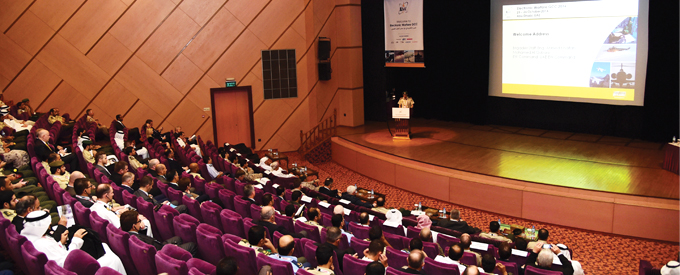2016-12-04
Electronic Warfare GCC attracts top experts
The conference provided a thorough analysis of the current and likely future threats to the Electronic Spectrum
Exploring the need for a persistent ISTAR environment and to debate the future innovation of electronic warfare in the Middle East, the Electronic Warfare (EW) GCC conference was held in Abu Dhabi during October 25-26. EW is seen as one of the integral elements in the formation of ISTAR. The role of EW in a wider STAR capability is where relevant information is collected, integrated and processed in order to meet the intelligence needs of senior military commanders. As ISTAR is defined as s system of systems, EW GCC 2016 took a deeper look at EW interoperability and how it must integrate and combine with other sensors to conduct mission support to the intelligence, surveillance, target acquisition and reconnaissance components of ISTAR.
ISTAR capabilities are being called for right across the air, ground and maritime area of responsibility. Electronic Warfare GCC 2016 provided a thorough analysis of the current and likely future threats to the Electronic Spectrum, with a focus on the concepts and operating environments which will help to shape GCC thinking on Electronic Warfare in wider ISTAR setting.
This series of Conferences hosted by the UAE EW Command has grown out of the initial Defense Sensors Technology event in 2010, through Electronic Warfare for the Gulf Cooperative Council members in 2011, 2013, and 2014. According to senior officers, the conference, attended by over 300 delegates from 30 different countries, was the most important EW event in the region. Three valuable and well attended Workshops by Rockwell Collins, Leonardo and CSIR took place on the day preceding the Conference.
Participating in the conference, Air Marshal Philip Osborn RAF, Chief of Defense Intelligence for the UK, underlined the close links between the two countries and said: “To understand, manage and control the electromagnetic environment is a vital role in warfare at all levels of intensity. The outcome of future operations will be decided by the protagonist who does this to decisive advantage.” CDI’s message was echoed immediately by Mike Small, BAE System’s Cyber Defense Capabilities Subject Matter Expert, who immediately picked up on the importance of EW-Cyber Convergence. David Stupples, Professor of Electronic Warfare Systems Research at the City University of London, where he is Director of Cyber Security Sciences, spoke on ‘A future Perspective of Information Warfare’. A third presentation by Commander Dave Hewitt, Officer Commanding the Joint EW Operational Support Centre (JEWOSC) in UK drew on his extensive experience as a deep EW specialist. The Electromagnetic Operating Environment (EME) has exploded with the information age, military capability developments and environmental domains, leaving it ‘Complex, Congested and Contested’, he said.Lt Col Mohamed Alzaabi who had been trained in the US brought a fresh perspective with his presentation on Electronic Warfare in the fight against terrorism. “We confront a not unsophisticated foe, with Insurgents/Terrorists adept at harnessing all three elements of EW (ESupport, EAttack & EProtection) and integrating Electromagnetic and Cyberspace operations using emerging technology,” he told the conference. His detailed presentation illustrated taking the fight to the enemy with EW providing Deny, Disrupt, Destroy, Degrade, and Deceive, while Cyber aims at breaking one or more of the information properties, Confidentiality, Integrity and Availability.
Colonel Mohamad al Bataineh, Director, Electronic Warfare for the Royal Jordanian Air Force, briefed on the C3 and EW capabilities of the RJAF and their application in the Combined Joint Task Force for Operation Inherent Resolve (OIR) against Daesh. This recognized the limitation of air power, the importance of information sharing, avoidance of collateral damage, need for organic CSAR and Inflight refueling and the value of UAVs. Above all it is non-conventional warfare and needs non-conventional tactics, he pointed out Michael Pefley, Director of Business Development, Northrop Grumman, spoke on “Open Architecture Leading to Mission Success.” He emphasized that EW and ISTAR must work together. Jean-Michel Eustache, SIGEN Program Director for Thales, highlighted ISR/EW challenges and linked the EW elements of EP, EA and ES to SIGINT (Signal Intelligence) for Operational Efficiency.
Graziano Lubello, NCW and Cyber EW Senior Expert for Electronica, introduced delegates to CEW&I, Cyber EW & Intelligence, a Conceptual, Operational and Technical Step Forward. In a practical example, he described how the US Airforce ISR group in Florida, using data gathered from Social Media, within 24 hours destroyed an ISIS HQ in Iraq. Such heterogeneous open source data is now essential to new generation ISTAR centers in providing an even more complete and updated cyber ‘Common Operational Picture/Situational Awareness”, he said.
Anton Van der Merwe on behalf of Scientific Research Partner CSIR, made a presentation on Innovations in Operational Test and Evaluation explaining how the increased complexity of threats requires sophisticated Networked, Multi-spectral training with the Convergence of EW and Cyber. Wimpie J Van den Berg representing GEW Technologies gave a stimulating closing presentation on Metadata – the DNA of a Signal in COMINT.
Coming from the not for profit Secure World Foundation, Brian Weeden, their Technical Director, highlighted the importance of Space in national security and military operations, as well as their vulnerabilities.
Conclusion
Clearly, appreciation of Cyber is growing rapidly and several Speakers provoked discussion on the convergence of Electronic Warfare and Cyber. The effects are similar, and some of the enablers such as technology and an intelligence-led approach are the same in both domains. Benefits to defense in promoting convergence can be seen in the use of existing structures and processes within EW to mobilize cyber more rapidly, as well as bridging the agreed shortage of cyber skills by re-brigading some of the operations and intelligence skills which exist in EW.


No Comments